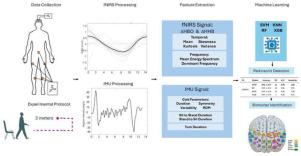利用fNIRS和IMU数据中的多模态脑-体生物标志物检测早期帕金森病
IF 6.3
2区 医学
Q1 BIOLOGY
引用次数: 0
摘要
帕金森病(PD)是一种进行性神经退行性疾病,损害运动和认知功能。PD的准确检测仍然是一个重大挑战,特别是在临床症状不明显的早期阶段。本研究提出了第一个集成功能近红外光谱(fNIRS)和惯性测量单元(IMU)数据的多模态机器学习框架,用于双任务机动性评估期间的早期PD检测。数据收集自62名参与者,包括28名PD患者和34名年龄匹配的对照组,他们进行了临床推荐的Timed Up and Go (TUG)、认知双任务TUG (CDTUG)和运动双任务TUG (MDTUG)测试。这个复杂的多模态实验设计同时捕获了运动和认知双任务条件下的大脑激活和身体运动。结合两种特征选择技术的四种机器学习模型分别应用于单峰和多峰数据集。与仅fnirs(87%)和仅imu(95%)模型相比,多模态方法获得了更高的分类准确率(96%)。确定了关键的脑-体生物标志物,包括双任务期间背外侧前额叶和额极皮层的激活,以及旋转、从坐到站和从站到坐的持续时间等运动特征。这些发现强调了将大脑和运动测量以及复杂的功能流动性测试结合起来用于早期PD检测的前景,并推动了非侵入性、人工智能驱动的生物标志物发现框架的发展。本文章由计算机程序翻译,如有差异,请以英文原文为准。

Early-stage Parkinson’s disease detection using multimodal brain–body biomarkers from fNIRS and IMU data
Parkinson’s Disease (PD) is a progressive neurodegenerative disorder that impairs both motor and cognitive functions. Accurate detection of PD remains a major challenge, particularly at early stages when clinical symptoms are subtle. This study presents the first multimodal machine learning framework integrating functional near-infrared spectroscopy (fNIRS) and inertial measurement unit (IMU) data for early-stage PD detection during dual-task mobility assessments. Data were collected from 62 participants, including 28 people with PD and 34 age-matched controls, who performed the clinically recommended Timed Up and Go (TUG), Cognitive Dual-Task TUG (CDTUG), and Motor Dual-Task TUG (MDTUG) tests. This complex multimodal experimental design simultaneously captured brain activation and body motion under motor and cognitive dual-task conditions. Four machine learning models combined with two feature selection techniques were applied to unimodal and multimodal datasets. The multimodal approach achieved superior classification accuracy (96%) compared to fNIRS-only (87%) and IMU-only (95%) models. Key brain–body biomarkers were identified, including dorsolateral prefrontal and frontopolar cortex activations during dual tasks, alongside motor features such as turn, sit-to-stand, and stand-to-sit durations. These findings highlight the promise of combining brain and motion measures and complex functional mobility tests for early-stage PD detection and advance the development of non-invasive, AI-driven biomarker discovery frameworks.
求助全文
通过发布文献求助,成功后即可免费获取论文全文。
去求助
来源期刊

Computers in biology and medicine
工程技术-工程:生物医学
CiteScore
11.70
自引率
10.40%
发文量
1086
审稿时长
74 days
期刊介绍:
Computers in Biology and Medicine is an international forum for sharing groundbreaking advancements in the use of computers in bioscience and medicine. This journal serves as a medium for communicating essential research, instruction, ideas, and information regarding the rapidly evolving field of computer applications in these domains. By encouraging the exchange of knowledge, we aim to facilitate progress and innovation in the utilization of computers in biology and medicine.
 求助内容:
求助内容: 应助结果提醒方式:
应助结果提醒方式:


